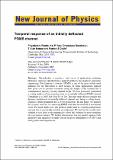Temporal response of an initially deflected PDMS channel
Author(s)
Doyle, Patrick S.; Panda, Priyadarshi; Yuet, Kai P.; Dendukuri, Dhananjay; Hatton, T. Alan
DownloadDoyle_Temporal response.pdf (802.3Kb)
PUBLISHER_POLICY
Publisher Policy
Article is made available in accordance with the publisher's policy and may be subject to US copyright law. Please refer to the publisher's site for terms of use.
Terms of use
Metadata
Show full item recordAbstract
Microfluidics is used in a wide array of applications including photonics, catalysis, optoelectronics, particle synthesis, bio-diagnosis and tissue engineering. Poly(dimethyl) siloxane (PDMS) is one of the most widely used materials for the fabrication of such devices. In many applications, applied flow gives rise to pressure variations along the length of the channel and a commensurate spatially varying channel height. We have previously performed a scaling analysis of the relaxation time of an initially deflected PDMS channel (Dendukuri et al 2007 Lab Chip 7 818–28). The prior study did not consider the dynamic evolution of the initially deflected channel and, being a scaling theory, required a fitting parameter for a priori predictions. In this paper, we analyze the dynamic behavior of a retracting PDMS wall after the removal of an external stress. For small deflections, the problem lends itself to a regular perturbation analysis that is analytically solvable at zeroth order. We find that the zeroth-order solution is very close to the numerically solved full solution for most situations of experimental interest. We further demonstrate that our model captures both qualitative and quantitative trends seen in the prior (Dendukuri et al 2007) and newly performed experiments.
Date issued
2009-11Department
Massachusetts Institute of Technology. Department of Chemical EngineeringJournal
New Journal of Physics
Publisher
Institute of Physics
Citation
Priyadarshi Panda et al. “Temporal response of an initially deflected PDMS channel.” New Journal of Physics 11.11 (2009): 115001. © 2009 IOP Publishing.
Version: Final published version
ISSN
1367-2630